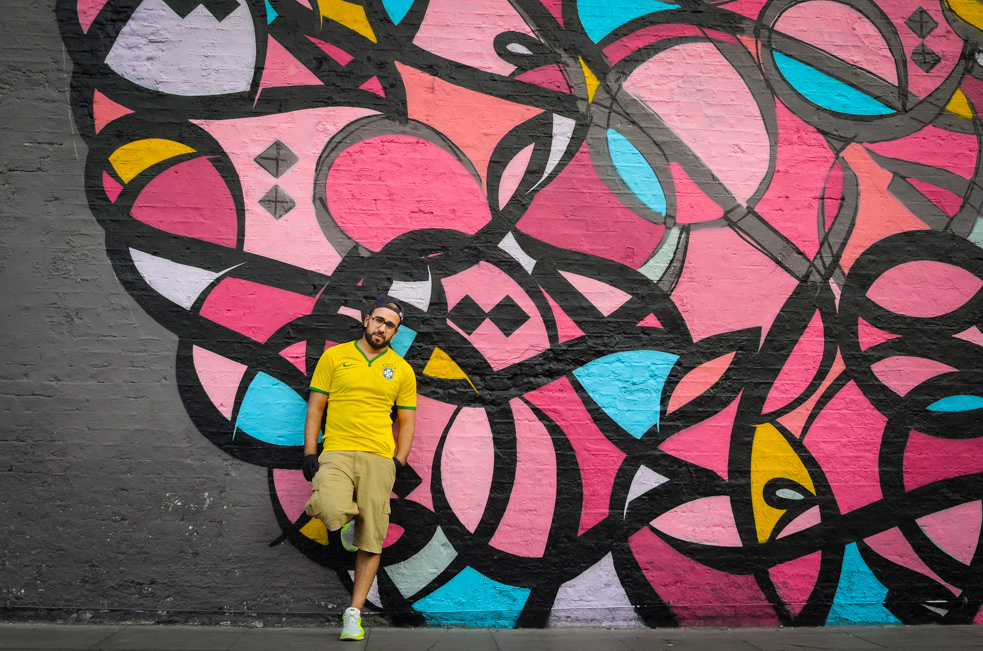
This wall looks abstract. But it reads: “It is one thing to show a man that he is in error, and another to put him in possession of the truth.” Artist eL Seed painted this John Locke quote for the Shubbak Festival in Shoreditch, London. Here, he poses in front of the mural in progress, after two days of painting. Photo: Karen Eng
Artist eL Seed fuses the beauty of Arabic letters with the modern art of graffiti — an art form he calls calligraffiti. He paints colorful, undulating messages of hope and peace on buildings all over the world — from the favelas of Rio de Janeiro, to the bridges of Paris (the city where he was born), to the minaret of the mosque in Gabès, Tunisia (his family’s hometown).
We caught up with eL Seed a few weeks ago in Shoreditch, London, where he was painting a large-scale mural as part of the Shubbak Festival — his first UK commission. As he worked high above the street in a cherry-picker lift, the spectacle of his painting slowed traffic and drew a crowd of pedestrians. He took a break to talk to the TED Blog about growing up as an Arab in Paris, and how becoming a graffiti artist who uses Arabic script has shifted his perception of who he is.
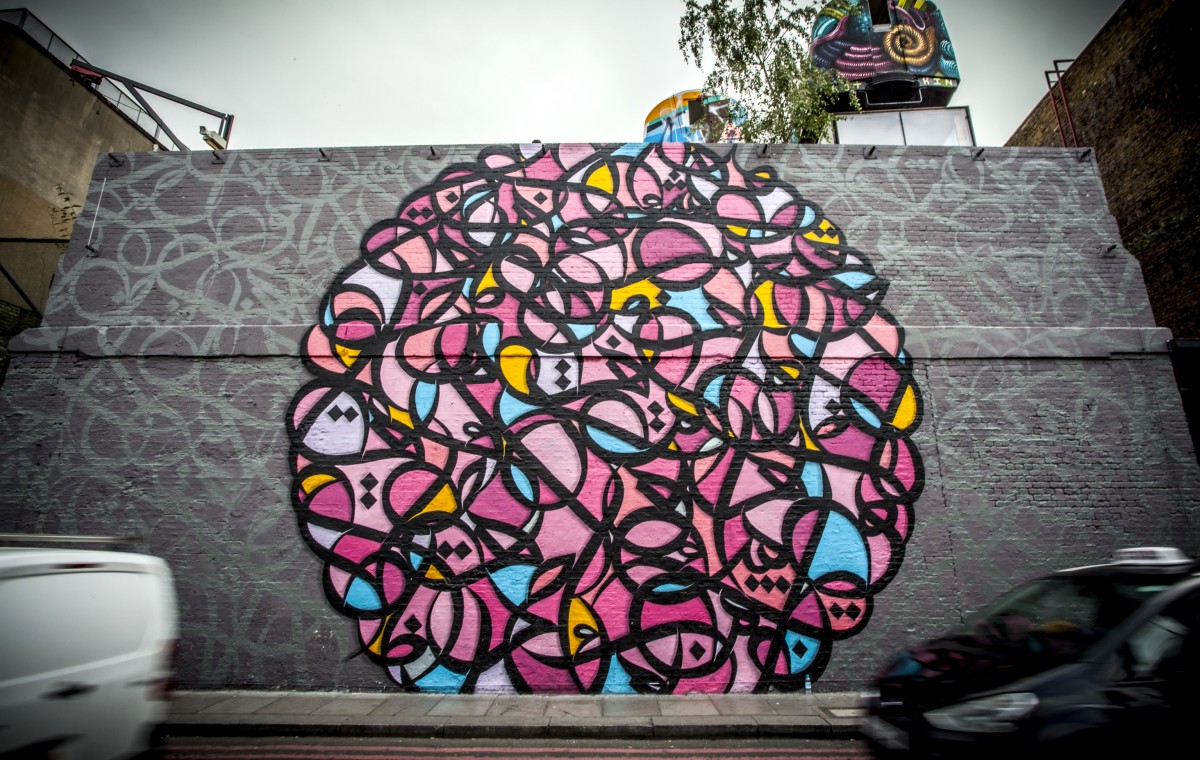
EL Seed’s murals deliver messages of hope and inspiration in graphic, swirling Arabic script. The completed piece in Shoreditch, London. Photo: Michael Brydon
What is this latest piece about, and how did it come about that you’re painting it?
The Shubbak Festival contacted me two years ago, asking me to come paint in London. They found me this wall, so I’m here for three days to paint it. The quote is from English philosopher John Locke, translated into Arabic: “It is one thing to show a man that he is in error, and another to put him in possession of truth.”
I chose this quote because I’m making this piece weeks after the massacre in Sousse, Tunisia, and the shooting in Charleston the same month. As a Tunisian man coming to the UK, I think the quote opens up a dialogue about the collective responsibility we have toward each other. War is individualistic — we always put blame on someone else. “It’s not my fault. It’s not my problem.” But the responsibility lies with all of us. It is our responsibility to bring those who perpetrate the crimes back, as well as to find a way to keep it from happening again.
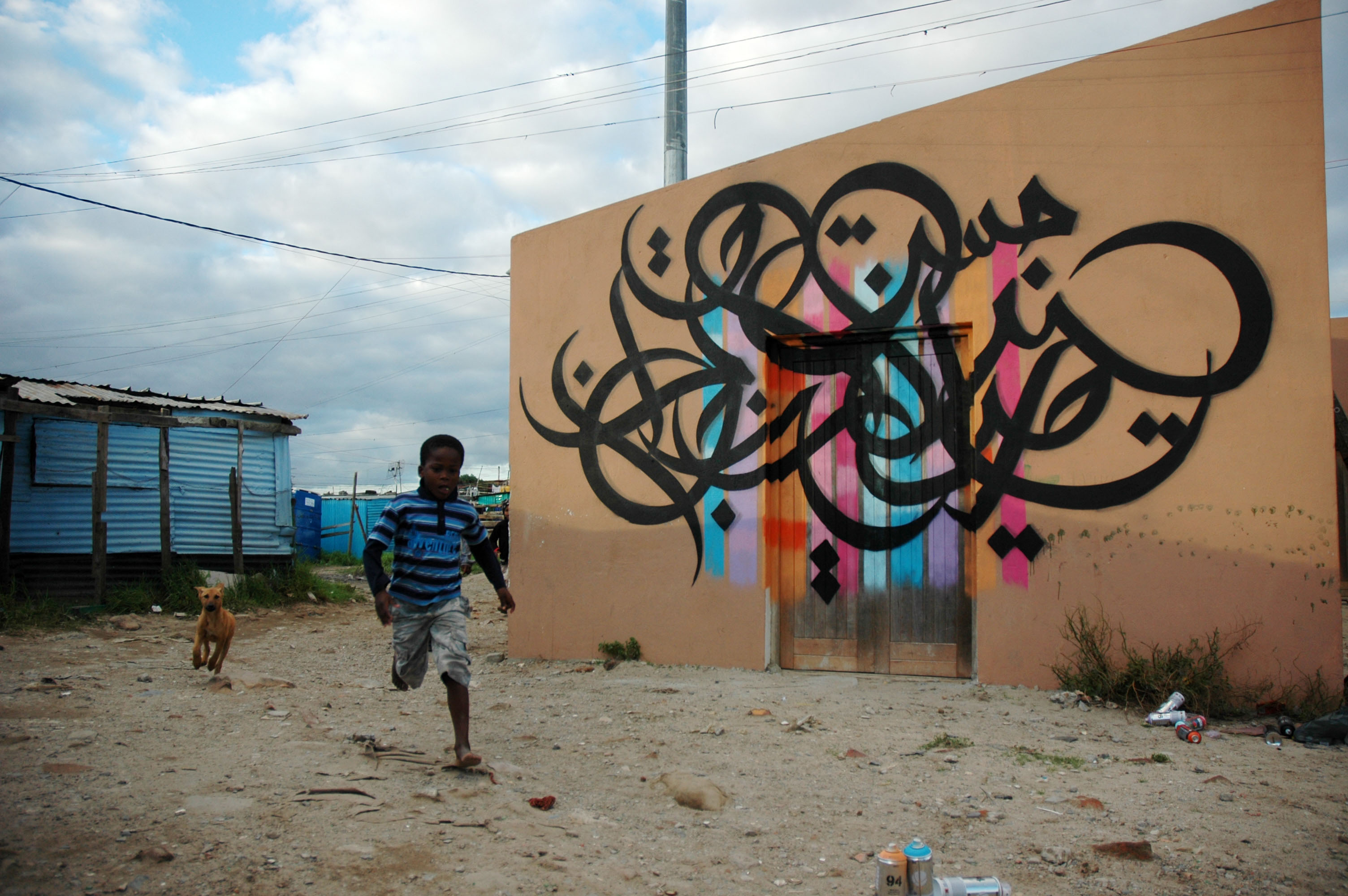
A Nelson Mandela quote on a wall in Cape Town, South Africa: “It always seems impossible until it’s done.” Photo: Kent Lingeveldt
You’re Tunisian but grew up in a suburb of Paris. What language did you speak growing up?
My parents used to speak us in Arabic when we were young, but we used to reply in French. Now that we’re grown up, we speak to them in Arabic — and they reply to us in French. I noticed that recently. I suppose for me, speaking Arabic now is a way to say that I’ve accepted my roots and that I’m proud of who we are. And when my parents reply in French, they’re showing that they have spent years in France and speak French as well.
How much time did you spend in Tunisia?
We used to go every summer, for about one and a half or two months. When I add up all those summers, I spent a total of two years and three months there. My parents made sure that I stayed connected to Tunisia. It was important for them — and I’m glad, because I learned to speak the Tunisian dialect.
Language was important. To make it in France, you cannot be French and something else. They make you choose, in a way. So most sons of immigrants in France didn’t feel French, even though we were growing up there. I went to a school that was segregated from mainstream French society, that was mostly Arab and Black kids. This segregation follows you into adulthood. When I was a kid, saying to someone “You’re French” was worse than insulting their mother. Claiming to be French was an act of denying our roots, and our culture.
To French people, I’m Arab, because of my face and my name. So I decided to get into my Arab roots. I took night classes to learn Arabic. That’s how I discovered Arabic calligraphy. I really wanted to learn it, but I couldn’t find a teacher. Classical Arabic calligraphy has many rules. To do it properly, you need to be taught by a master who was taught by a master — a tradition going back 1,400 years.
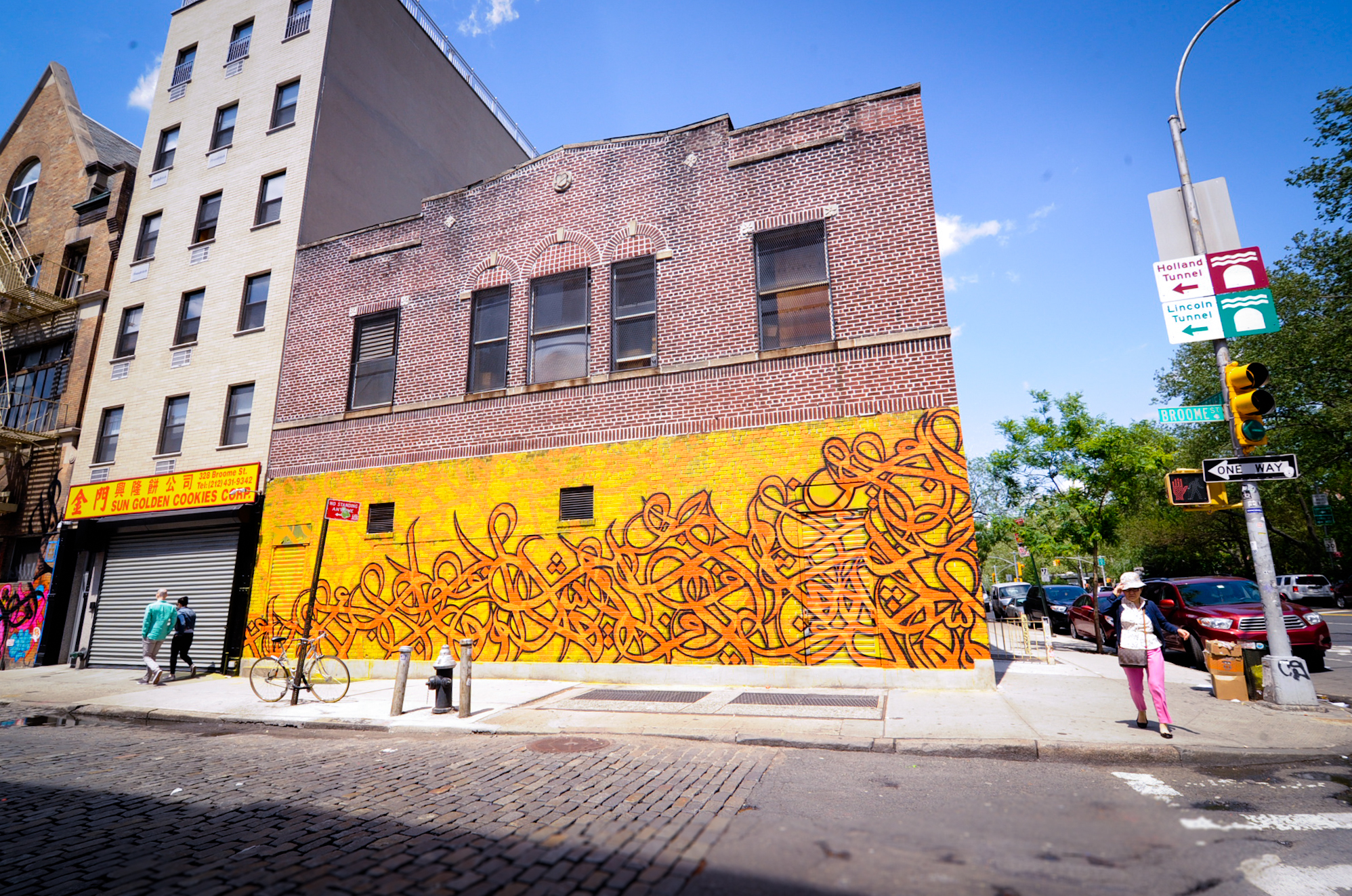
Lao Tzu’s words in New York City: “The more you go to the East, the more you reach the West.” Photo: Rika Prodhan
Was your first graffiti done in Arabic?
No. It was a time when most kids were into hip-hop, graffiti and breakdancing. When I started, I was also going to school to pursue a career in business. Then in 2006, I moved to New York and got a job as a logistics manager. I was in charge of three warehouses — $10 million of pharmaceutical stock. I was 24, and I stopped doing graffiti to focus on my job. But it called me back again. I met this guy called Hest in Montreal, a French graffiti artist. He wrote his name, H-E-S-T, in English but in Arabic shapes. He encouraged me to paint. After I saw his work, I realized I no longer wanted to paint in Roman letters. We painted together for three months, and then he moved to Indonesia. But I always tell him, without him, I wouldn’t be here today. That was about ten years ago.
So you never did learn classical Arabic calligraphy. How are you so fluent with your Arabic and shapes?
I had learned how to read and write Arabic; I just created my own style, not at all connected to classical calligraphy. The shapes just come out of me naturally. Maybe it’s because I don’t know classical calligraphy; I didn’t feel limited by all the rules. I just started extending my letters and, without realizing it, I was creating my own thing. People would say, “What are you doing? You’re not respecting the rules of calligraphy.” I’d say, “No, I don’t want to learn them. I just want to see who I am.” Because this is art. You cannot be limited in art.
People who read Arabic can decipher it, especially if I give them the quote. But it is hard to read. And that’s fine.
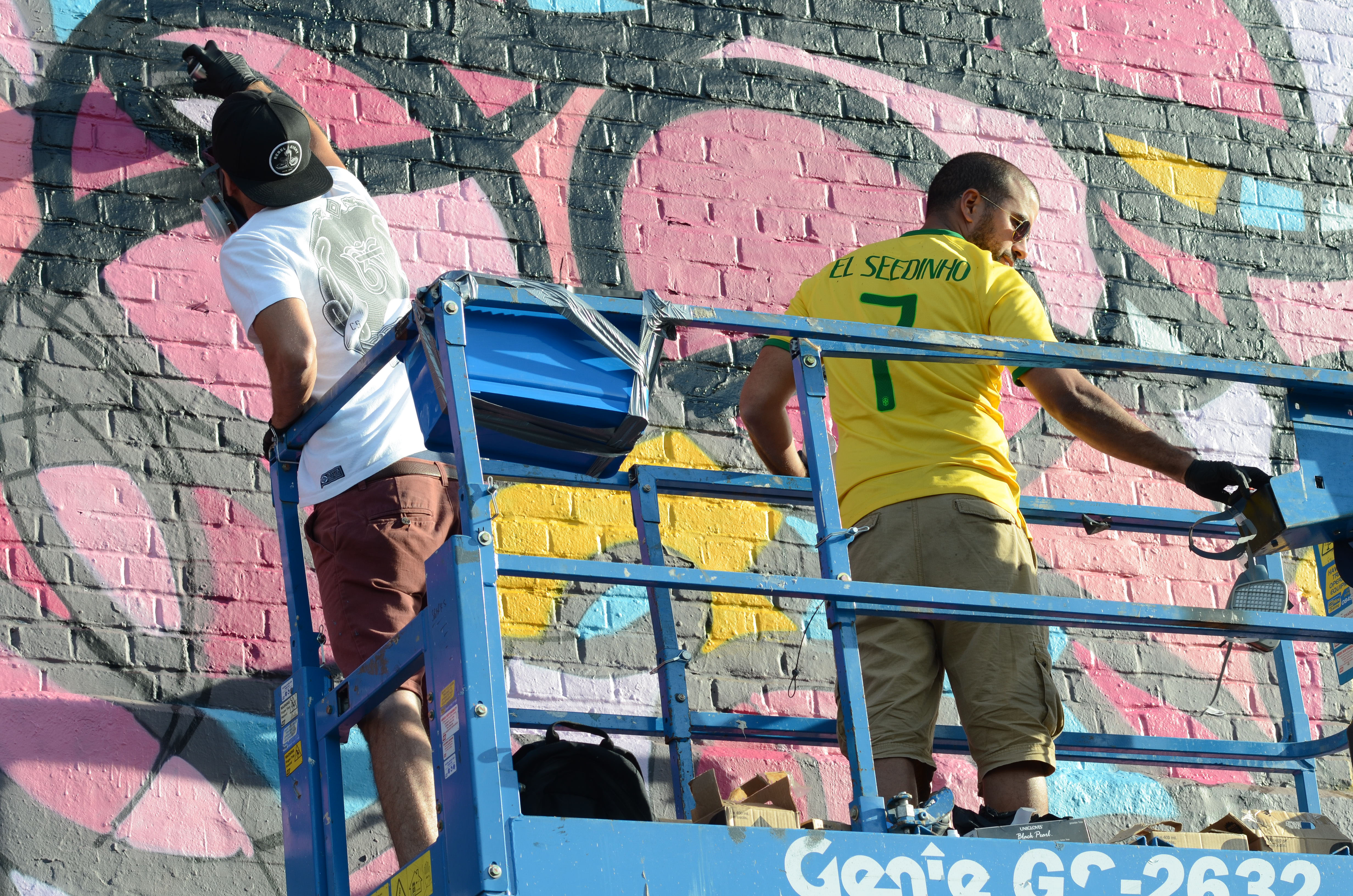
Along with his assistant, Myneandyours, eL Seed paints in Shoreditch. He works freehand, from simple preliminary sketches. Photo: Karen Eng
How did your story unfold from there?
Well, I got fired from my job in New York. My boss said I was good at my job, but he told me, “It’s time for you to move on.” I said, “Okay.” Last month, I was visiting the city and called him to say, “You know, you were right. It was time for me to move on.”
I moved to Montreal and found another job, because my art wasn’t bringing in any money. That changed in 2007. People started sharing my work on social media. This is how I built a following: I would paint at street art festivals and post photos online, on the group pages of institutions and museums. Once, I uploaded a photo of my work on the Facebook page for The Museum of Islamic Art in Qatar. A few years later, they contacted me and said, “We don’t know who you are, but we found your picture in our gallery, and we would like to do a project with you.” Now I get commissions, in addition to my own projects.
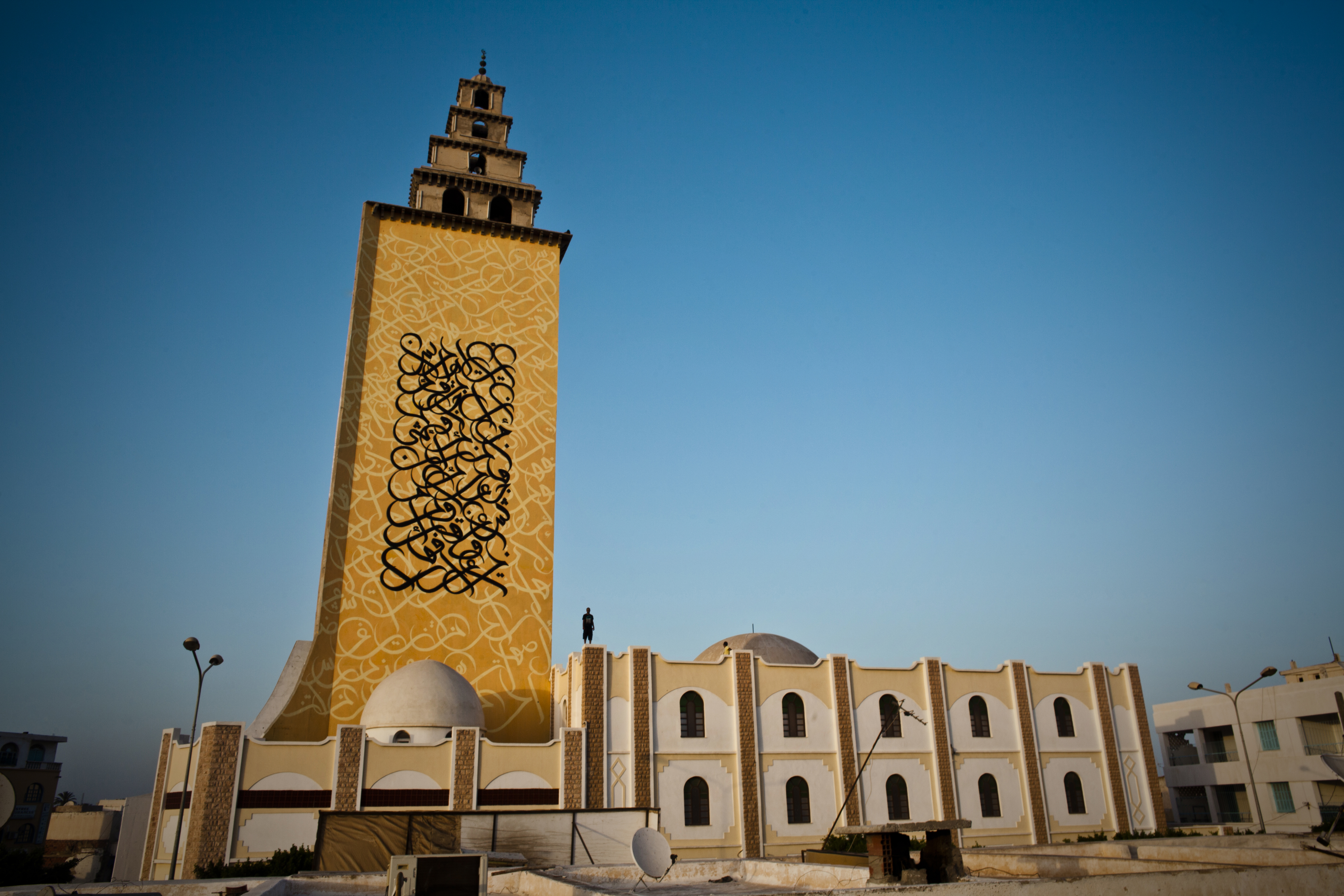
eL Seed painted a verse from the Koran on the minaret of this mosque in Gabès, Tunisia, his family’s hometown. It reads: “O humankind, we have created you from a male and a female and made you people and tribes, so you may know each other.” Photo: Courtesy of eL Seed
Tell us about the project in Gabès, Tunisia.
Three or four years ago, I wanted to paint the minaret on the mosque in my family’s hometown. The minaret was built in 1994, and for 18 years the 47 meters of concrete stayed grey. When I approached the imam and told him what I wanted to do, he said, “Thank god, you finally came.”
He didn’t ask me for anything — no sketch, no quote. I painted a verse from the Koran, because it was a mosque. The quote is: “O humankind, we have created you from a male and a female and made you people and tribes, so you may know each other.” It’s a call for peace, inspired by a clash at the time between secular and religious people in Tunisia about freedom of artistic expression. There were physical fights, and a curfew imposed. I didn’t paint the quote in response to this conflict, but the context helped me choose it.
The feedback was great from media around the world. Gabès was a city that nobody knew — and suddenly, it was on the map. Now people know Gabès because of its minaret. The imam really wanted this piece to be a monument. He wanted people to come to the city and visit the mosque. It looks like it worked.
How did you follow that up?
I decided I wanted to show the heritage of Tunisia, and took a road trip across the country to find its forgotten history. I went from town to town, meeting people and asking them about the history of the place. Based on these conversations, I painted 24 walls in 17 cities over one month. From this, I made a book called Lost Walls.
It was super cool, driving, stopping and meeting people. In one city, we entered pretending we were part of a wedding. We joined the procession, pretending we were photographing the wedding, and they said, “Okay, guys. Come in. It’s time for the dinner rehearsal.” We sat at a table with people — we had no idea who they were. We were eating, and then the guy beside me asked, “Are you from the groom’s family?” I said, “No, we just followed you.” Then I showed him my work. It turned out he knew it, and spent three days with us, showing us around.
The whole project was like that. Most of the people were really happy to see us and what we were doing.
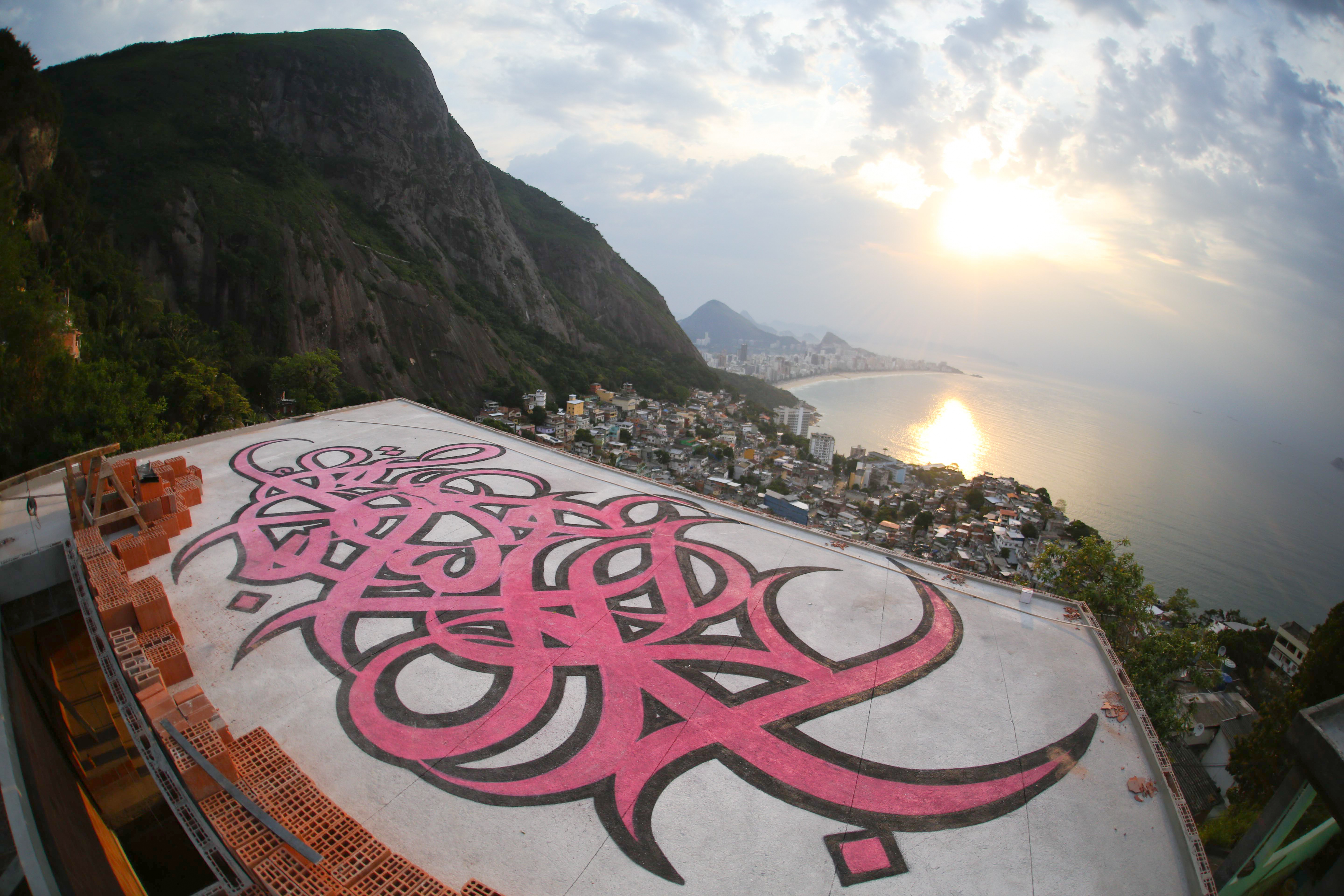
In the Vidigal favela in Rio de Janeiro, Brazil, eL Seed painted words from poet Gabriela Torres Barbosa: “You forgot how to love your people, to love your country, country of the poor, country of the black.” Photo: Henrique Madeira
You travel all over the world to paint. Are you usually invited, or do you just turn up?
It’s a combination. I was invited to give a talk in South Africa, so I gave the talk and then painted. In Brazil, I was invited for a festival, so they were ready for me to paint inside the city. Afterwards, I had a couple of days, so I said, “I need to go to the Vidigal favela.” And I just did it.
I’ve painted a slum in Cape Town; I recently painted in Mykonos in Greece. In Mykonos, you can’t paint just anywhere, because it’s legislated that everything has to be white and blue. But I met this woman who sold me shoes. She introduced me to an old man, who brought me to another woman, whose husband owned a hotel. I said, “I want to paint on your rooftop so I can take a picture and people can see the city behind the painting.” He said, “But we can’t.” I told him I was trying to meet with the mayor of the city — which I wasn’t. Finally I said, “After I do the painting and take the picture, I’ll paint over it in white.” When I finished, he decided to keep it.
People are very welcoming and receptive. There’s a universal beauty in Arabic script that anybody can feel. I can write “bullshit” in Arabic, and people are like, “Wow, that’s beautiful!” I did it once, in Qatar. I was doing a workshop with a student who said, “What should we write?” And I said, “Let’s write ‘bullshit.’” It looked nice!
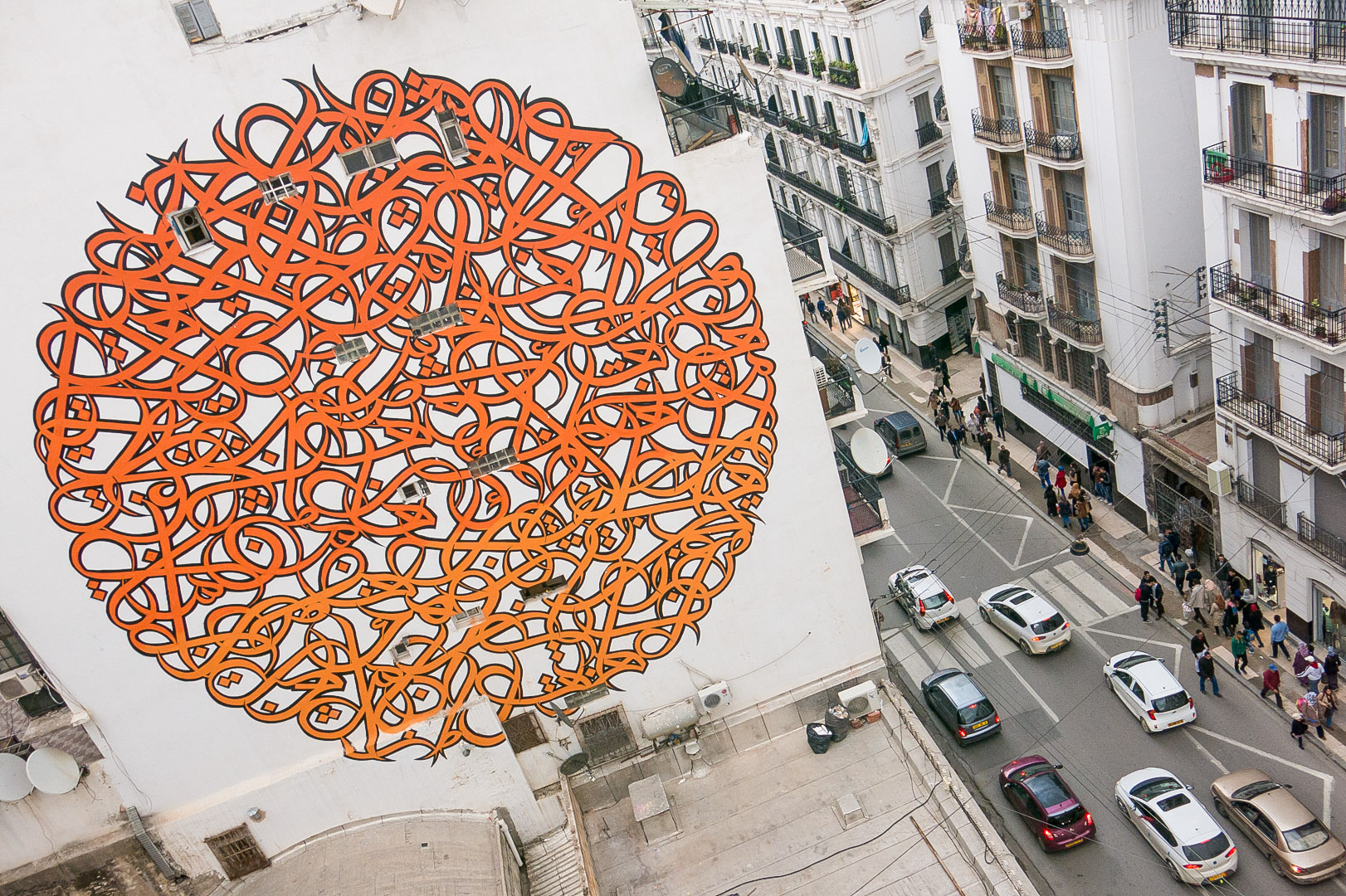
“How could I forget the land of good? How could my heart be in peace?” In Didouche Mourad, Algeria, a line from a song by popular Algerian singer Dahmane El Harrachi. Photo: eL Seed
Is it the place that inspires you in the moment? Or do you have a plan in mind when you travel?
It’s the place that inspires me. Most of the time, it’s freestyle. There’s no plan; I go, and it happens. I speak with the people, I discover something. The coolest thing is the human experience of meeting people, having crazy adventures and sharing experiences. The best part of what I do. One day I’m going to do a book about that — not about the painting, but about all the stories.
Even if people can’t read the script, they seem to respond to the art. Here in London, a lot of passersby are stopping and asking questions. But Arab people seem particularly excited.
Yes. It touches their pride. When you paint a huge Arabic piece in a Western city, they’re like, “Wow.” I painted the Pont des Arts, the bridge in Paris where people used to put locks as a token of their love. They recently removed the locks and asked me to paint the bridge.
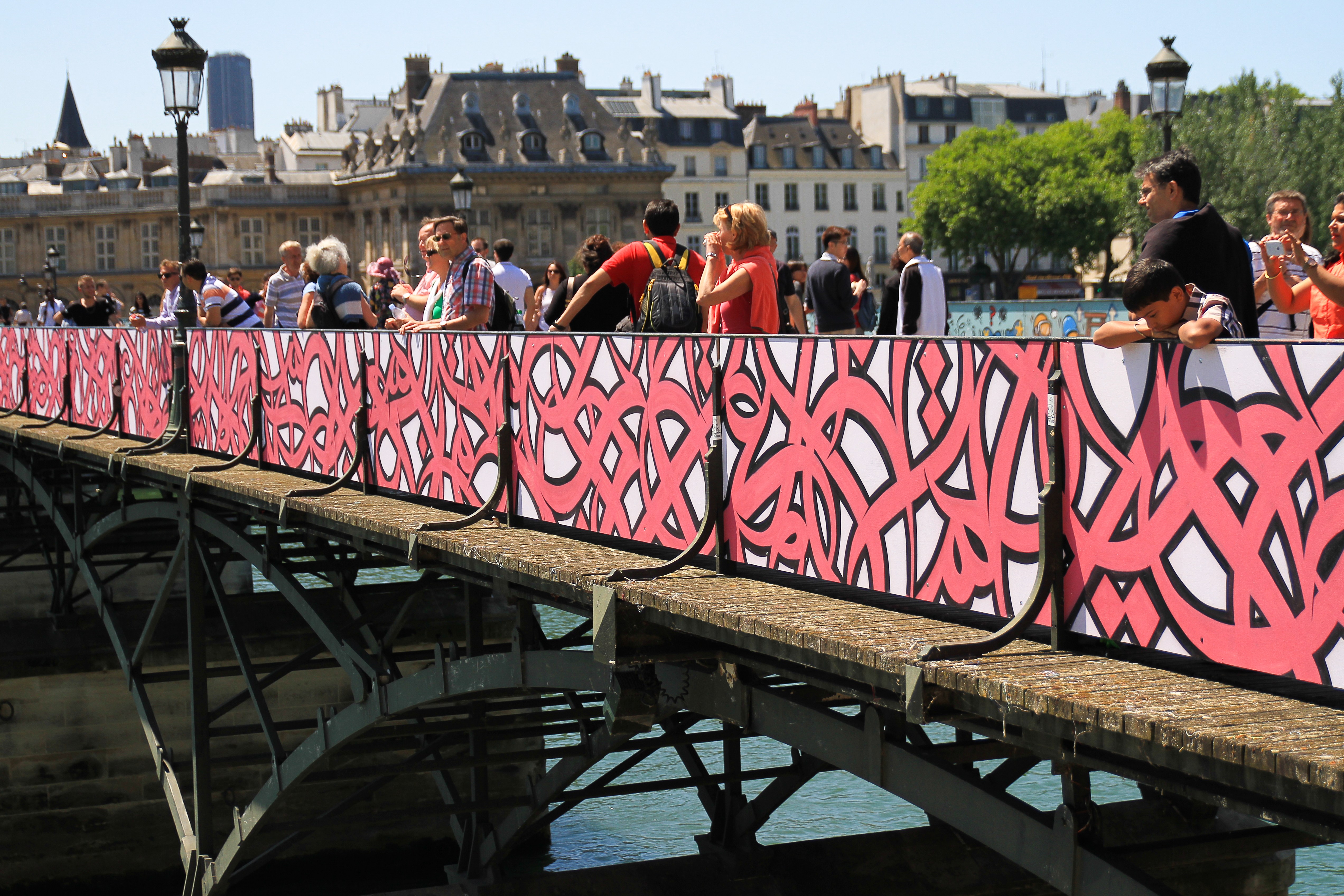
“Paris is a veritable ocean. Plumb it, you will never know its depths.” The Pont des Arts in Paris, once the “love locks” bridge, is now decorated by a quote from Balzac. Photo: Courtesy of eL Seed
That’s an iconic bridge. Does that mean that the Paris establishment is accepting you, and how does this sit with your experience of having grown up not really feeling French?
That is true — it is a symbol of Paris. This bridge was built by Napoleon in 1802. And 200 years later, I come and paint on it!
But since I’ve doing Arabic calligraphy, I have felt French. Something about not following the rules and creating my own style changed my perception of my identity. I recently bought a French soccer jersey. I would never have done that ten years ago. I’ve accepted my French identity — as part of the whole, which is also part Arab, part Tunisian, part Muslim, part hip-hop. All of that has made me who I am today.
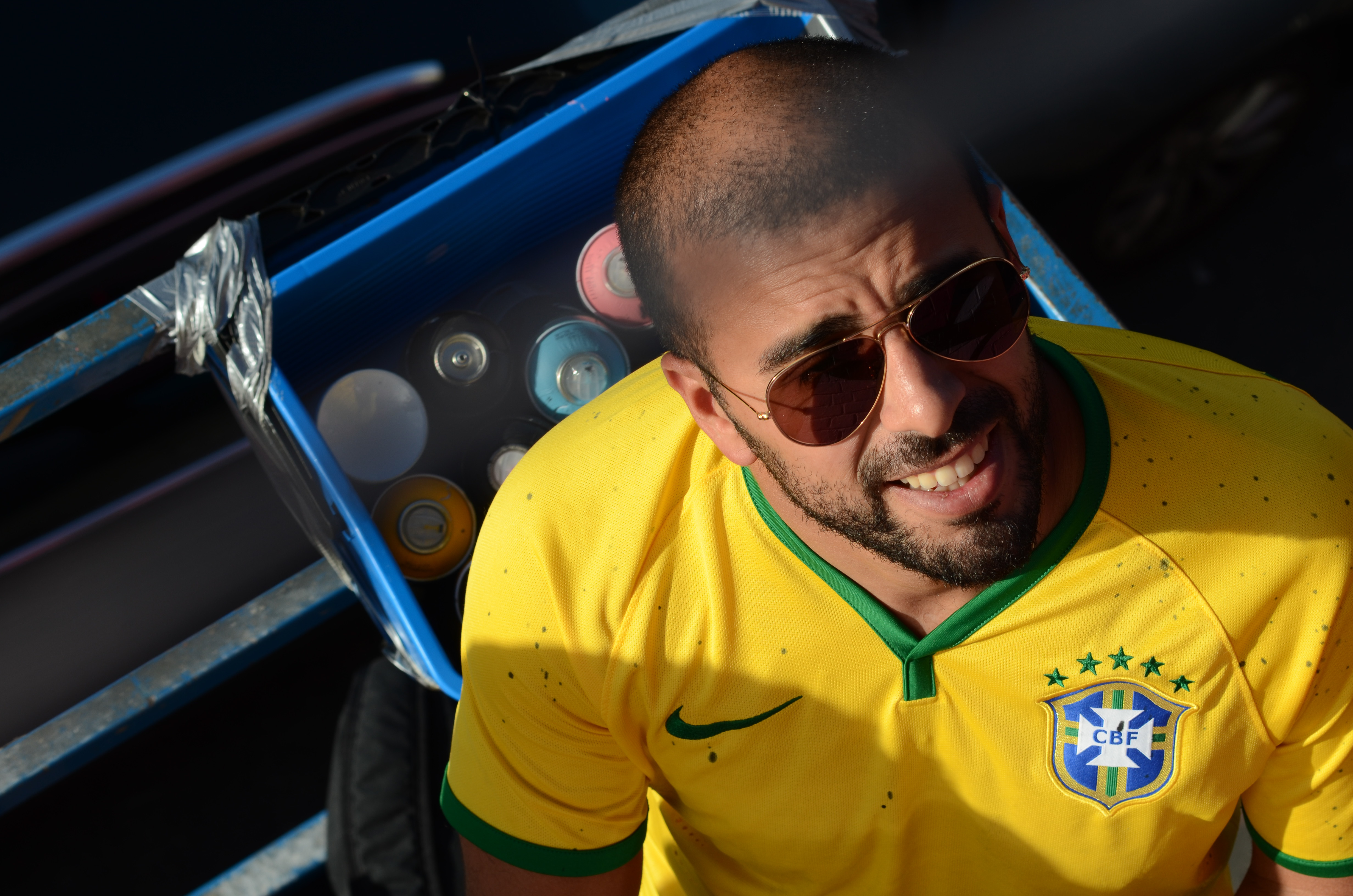
Artist eL Seed works on a cherry-picker lift high above the streets of London. Photo: Karen Eng
Comments (4)